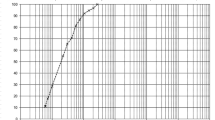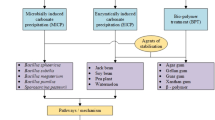Abstract
In this study, the effect of ground granulated blast furnace slag (GGBFS) and recycled construction waste (CW) on bentonite clay stabilisation were investigated. The unconfined compressive strength (UCS) of specimens was evaluated with different combinations of GGBFS and CW over various curing periods. A series of micro analysis tests consisting of scanning electron microscope, energy dispersive spectrometer and X-ray diffraction were also conducted to determine the microstructural arrangement and mineralogical effect of the stabilisation treatment. The UCS results showed an increment in strength after introduction of GGBFS and CW and the longer curing period produced more pronounced results. The optimum additive ratio was calculated as 5 % of slag and 20 % of construction waste under all curing conditions. The micro analytical results also indicated formation of structural bonds between admixtures and bentonite in stabilised specimens, as slag crystals and bentonite particles were observed to occupy the cavities and vesicles on the construction waste grains. However, the experimental data shows that the strength improvement is not significant with the addition of only construction waste.




















Similar content being viewed by others
References
Abdelrahman GE, Mohamed HK, Ahmed HM (2013) New replacement formations on expansive soils using recycled EPS beads. In: Proceedings of 18th ICSMGE
Al-Malack MH, Abdullah GM, Baghabra Al-Amoudi OS, Bukhari AA (2014) Stabilization of indigenous Saudi Arabian soils using fuel oil flyash. J King Saud Univ Eng Sci. doi:10.1016/j.jksues.2014.04.005
Al-Rawas AA, Hago AW, Al-Sarmi H (2005) Effect of lime, cement and Sarooj (artificial pozzolan) on the swelling potential of an expansive soil from Oman. Build Environ 40(5):681–687. doi:10.1016/j.buildenv.2004.08.028
Amiralian S, Budihardjo MA, Chegenizadeh A, Nikraz H (2015) Study of scale effect on strength characteristic of stabilised composite with sewage sludge—part A: preliminary study. Constr Build Mater 80:339–345. doi:10.1016/j.conbuildmat.2014.07.117
Amu OO, Fajobi AB, Afekhuai SO (2005) Stabilizing potential of cement and fly ash mixture on expansive clay soil. J Appl Sci 5(9):1669–1673
Behera M, Bhattacharyya SK, Minocha AK, Deoliya R, Maiti S (2014) Recycled aggregate from C&D waste & its use in concrete—a breakthrough towards sustainability in construction sector: a review. Constr Build Mater 68:501–516. doi:10.1016/j.conbuildmat.2014.07.003
Birss FW, Thorvaldson T (1955) The mechanism of the hydration of calcium oxide. Can J Chem 33(5):881–886. doi:10.1139/v55-106
Chakradhara Rao M, Bhattacharyya SK, Barai SV (2011) Influence of field recycled coarse aggregate on properties of concrete. Mater Struct 44(1):205–220. doi:10.1617/s11527-010-9620-x
Cherian C, Arnepalli DN (2015) A critical appraisal of the role of clay mineralogy in lime stabilization. Int J Geosynth Ground Eng 1(1):1–20. doi:10.1007/s40891-015-0009-3
Deer WA, Howie RA, Zussman J (2013) An introduction to the rock-forming minerals, 3rd edn. Mineralogical Society of Great Britain & Ireland, London
Grim RE (1968) Clay mineralogy, 2nd edn. McGraw-Hill, New York
Hansen TC (1986) Recycled aggregates and recycled aggregate concrete second state-of-the-art report developments 1945–1985. Mater Struct 19(3):201–246. doi:10.1007/BF02472036
Hausmann MR (1990) Engineering principles of ground modification. McGraw-Hill, New York
Higgins DD (2005) Soil stabilisation with ground granulated blastfurnace slag. UK Cementitious Slag Makers Association (CSMA) report. Surrey
Horvath A (2004) Construction materials and the environment. Annu Rev Environ Resour 29(1):181–204. doi:10.1146/annurev.energy.29.062403.102215
Hyder Consulting (2011) Construction and Demolition Waste Status Report Environment Department of Sustainability, Water, Population and Communities and Queensland Department of Environment and Resource Management. http://www.environment.gov.au/system/files/resources/323e8f22-1a8a-4245-a09c-006644d3bd51/files/construction-waste.pdf
Kasai Y (1989) The Second International RILEM Symposium on demolition and reuse of concrete and masonry. Mater Struct 22(4):312–319. doi:10.1007/BF02472565
Khalaf F, DeVenny A (2004) Recycling of demolished masonry rubble as coarse aggregate in concrete: review. J Mater Civ Eng 16(4):331–340. doi:10.1061/(ASCE)0899-1561(2004)16:4(331)
Khemissa M, Mahamedi A (2014) Cement and lime mixture stabilization of an expansive overconsolidated clay. Appl Clay Sci 95:104–110. doi:10.1016/j.clay.2014.03.017
Kim HS, Park JW, An YJ, Bae JS, Han C (2011) Activation of ground granulated blast furnace slag cement by calcined alunite. Mater Trans 52(2):210–218
Limbachiya M, Meddah MS, Ouchagour Y (2012) Use of recycled concrete aggregate in fly-ash concrete. Constr Build Mater 27(1):439–449. doi:10.1016/j.conbuildmat.2011.07.023
McCarthy MJ, Csetenyi LJ, Sachdeva A, Dhir RK (2014) Engineering and durability properties of fly ash treated lime-stabilised sulphate-bearing soils. Eng Geol 174:139–148. doi:10.1016/j.enggeo.2014.03.001
Mitchell TK, Raad L (1973) Control of volume changes in expansive earth materials. Workshop on Expansive Clays and Shales in Highway Design and Construction, Denver, Colorado: Frost I Jord/Norway
National Research Council (2006) Geological and geotechnical engineering in the new millennium: opportunities for research and technological innovation. The National Academies Press, Washington, DC
Neeraja D, Rao Narsimha AV (2010) Use of certain admixtures in the construction of pavement on expansive clayey subgrade. Int J Eng Sci Technol 2(11):6108–6114
Nicholson PG (2014) Soil improvement and ground modification methods. Butterworth-Heinemann, Oxford
Ortega-López V, Manso JM, Cuesta II, González JJ (2014) The long-term accelerated expansion of various ladle-furnace basic slags and their soil-stabilization applications. Constr Build Mater 68:455–464. doi:10.1016/j.conbuildmat.2014.07.023
Phani Kumar BR, Sharma RS (2004) Effect of fly ash on engineering properties of expansive soils. J Geotech Geoenviron Eng 130(7):764–767
Poon CS, Chan D (2007) The use of recycled aggregate in concrete in Hong Kong. Resour Conserv Recycl 50(3):293–305. doi:10.1016/j.resconrec.2006.06.005
Saride S, Puppala AJ, Chikyala SR (2013) Swell-shrink and strength behaviors of lime and cement stabilized expansive organic clays. Appl Clay Sci 85:39–45. doi:10.1016/j.clay.2013.09.008
Schanz T, Elsawy MBD (2015) Swelling characteristics and shear strength of highly expansive clay–lime mixtures: a comparative study. Arab J Geosci 8(10):7919–7927. doi:10.1007/s12517-014-1703-5
Siddique R, Khan MI (2011) Supplementary cementing materials. Vol. 37, Engineering materials. Springer, Berlin
Snethen DR, Johnson LD, Patrick DM (1977) An evaluation of expedient methodology for identification of potentially expansive soils. US Army Engineer Waterways Experiment Station, USAEWES, Vicksburg, Mis. Report No. FHWA-RD-77-94
Song S, Sohn D, Jennings HM, Mason TO (2000) Hydration of alkali-activated ground granulated blast furnace slag. J Mater Sci 35(1):249–257. doi:10.1023/A:1004742027117
Standards Australia AS 1289.5.4.2 (2007) Methods of testing soils for engineering purposes—soil compaction and density tests—compaction control test—assignment of maximum dry density and optimum moisture content values
Standards Australia AS 5101.4 (2008) Methods for preparation and testing of stabilized materials—unconfined compressive strength of compacted materials
Thyagaraj T, Zodinsanga S (2014) Laboratory studies on stabilization of an expansive soil by lime precipitation technique. J Mater Civ Eng 24(8):1067–1075. doi:10.1061/(ASCE)MT.1943-5533.0000483
Wang J, Li Z, Tam VWY (2014) Critical factors in effective construction waste minimization at the design stage: a Shenzhen case study, China. Resour Conserv Recycl 82:1–7. doi:10.1016/j.resconrec.2013.11.003
Yadu L, Tripathi RK (2013) Effects of granulated blast furnace slag in the engineering behaviour of stabilized soft soil. Procedia Eng 51:125–131. doi:10.1016/j.proeng.2013.01.019
Zhao H, Liu J, Guo J, Zhao C, Gong B (2015) Reexamination of lime stabilization mechanisms of expansive clay. J Mater Civ Eng 27(1):04014108. doi:10.1061/(ASCE)MT.1943-5533.0001040
Acknowledgments
The authors acknowledge the use of Curtin University’s Microscopy and Microanalysis Facility, whose instrumentation has been partially funded by the University, State and Commonwealth Governments.
Author information
Authors and Affiliations
Corresponding author
Rights and permissions
About this article
Cite this article
Hasan, U., Chegenizadeh, A., Budihardjo, M.A. et al. Experimental Evaluation of Construction Waste and Ground Granulated Blast Furnace Slag as Alternative Soil Stabilisers. Geotech Geol Eng 34, 1707–1722 (2016). https://doi.org/10.1007/s10706-016-9983-z
Received:
Accepted:
Published:
Issue Date:
DOI: https://doi.org/10.1007/s10706-016-9983-z




